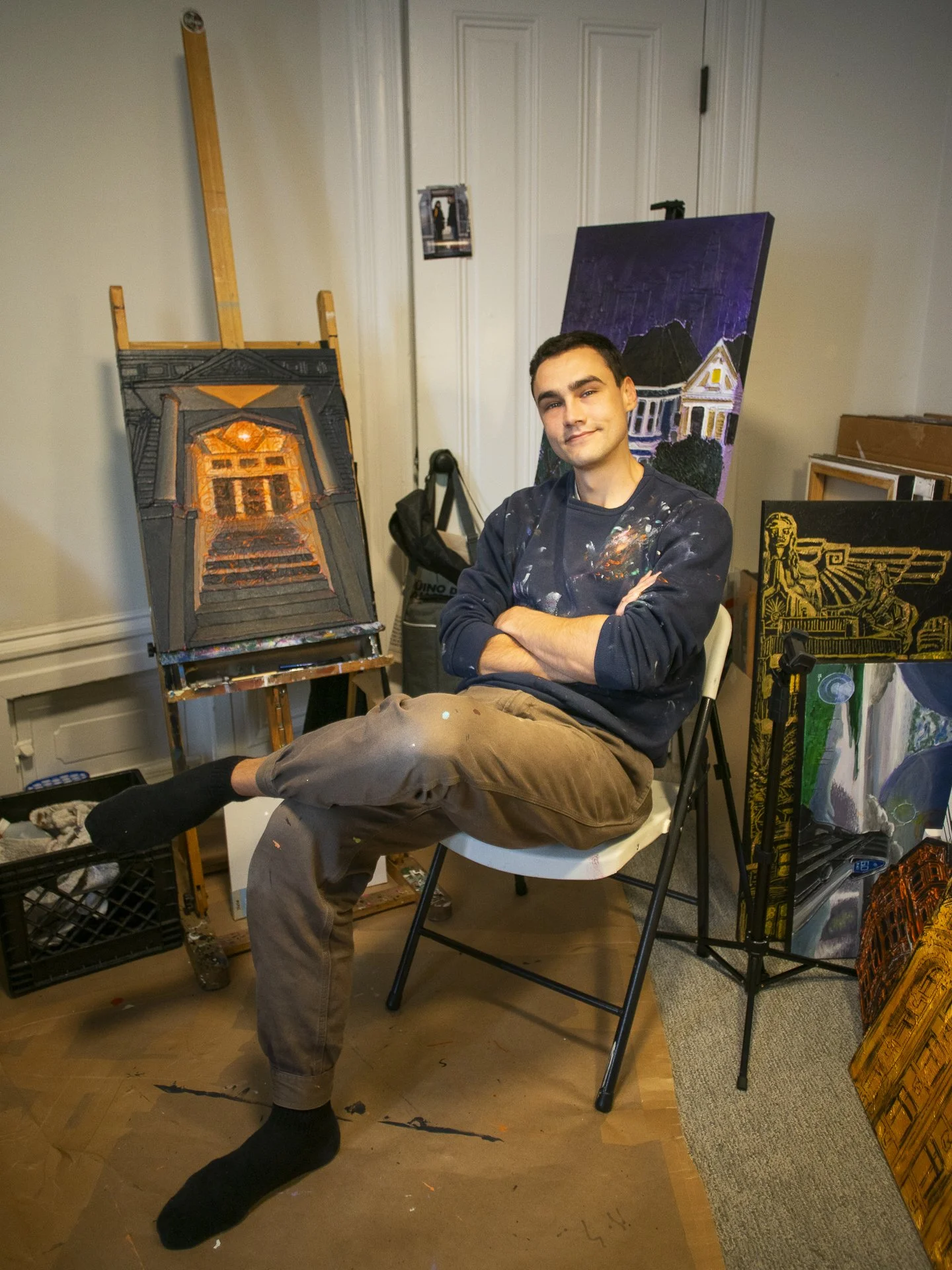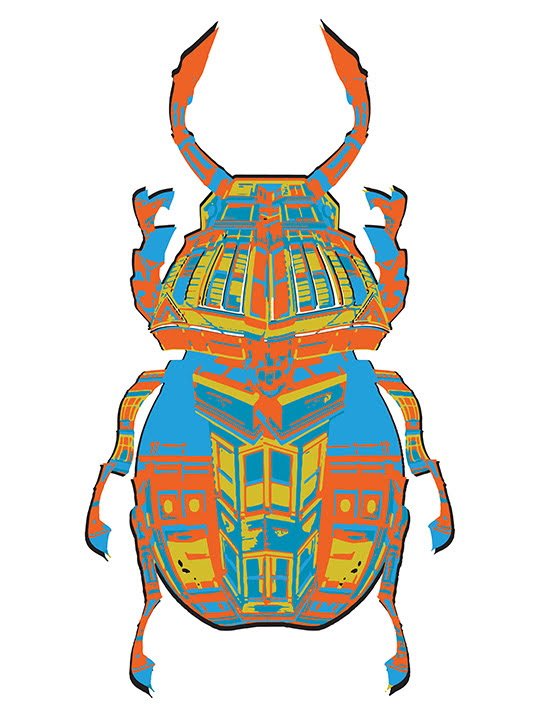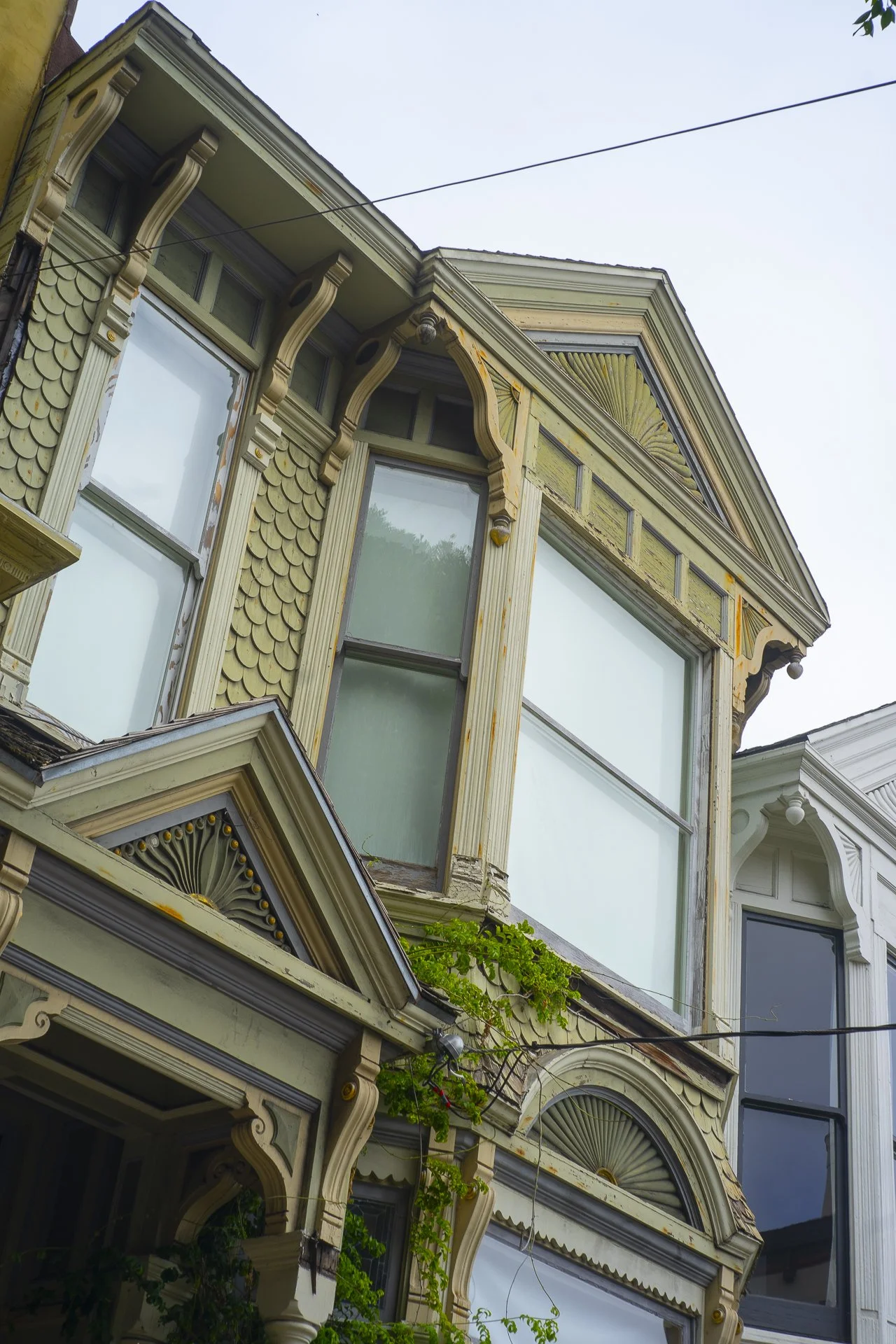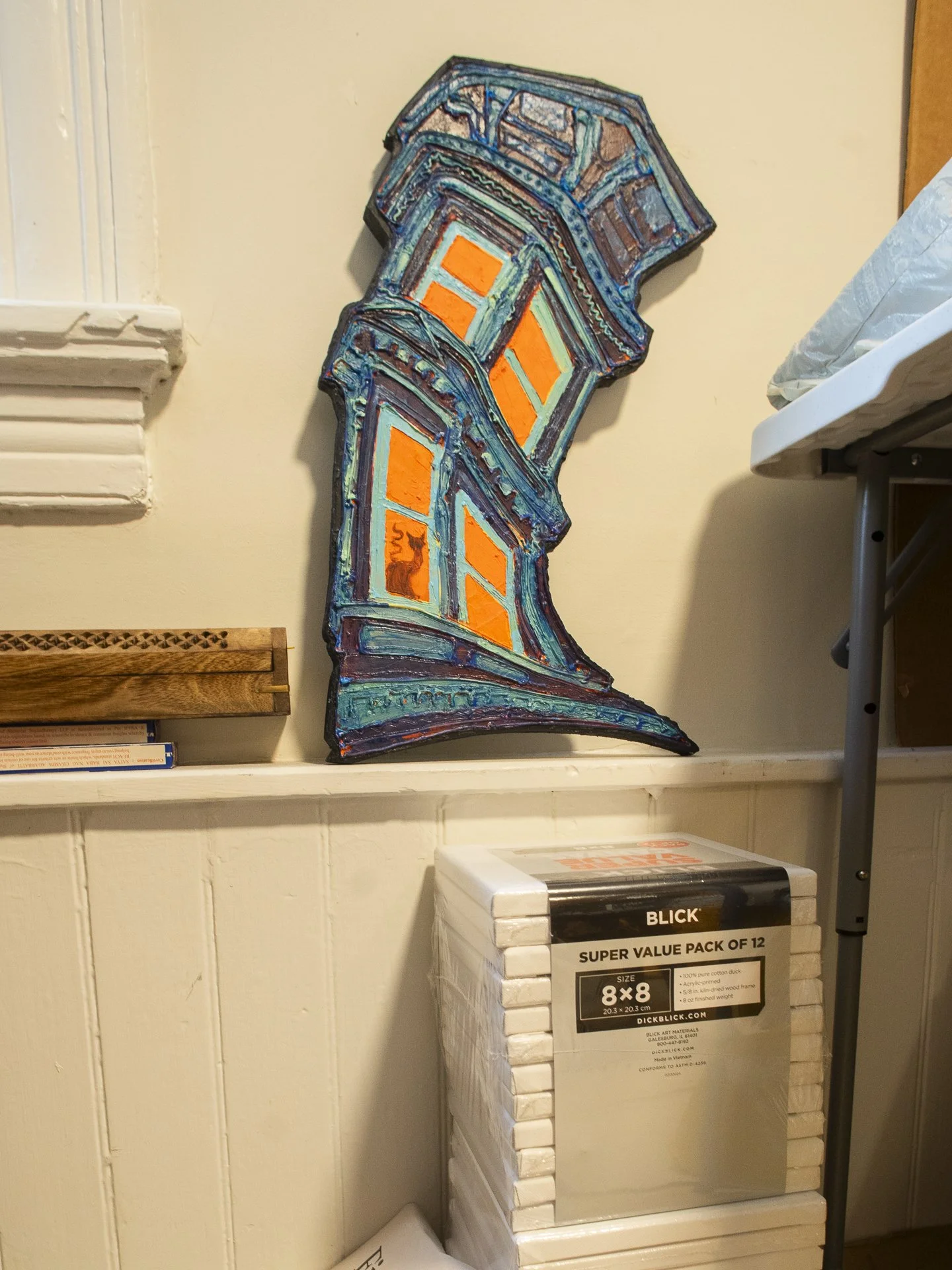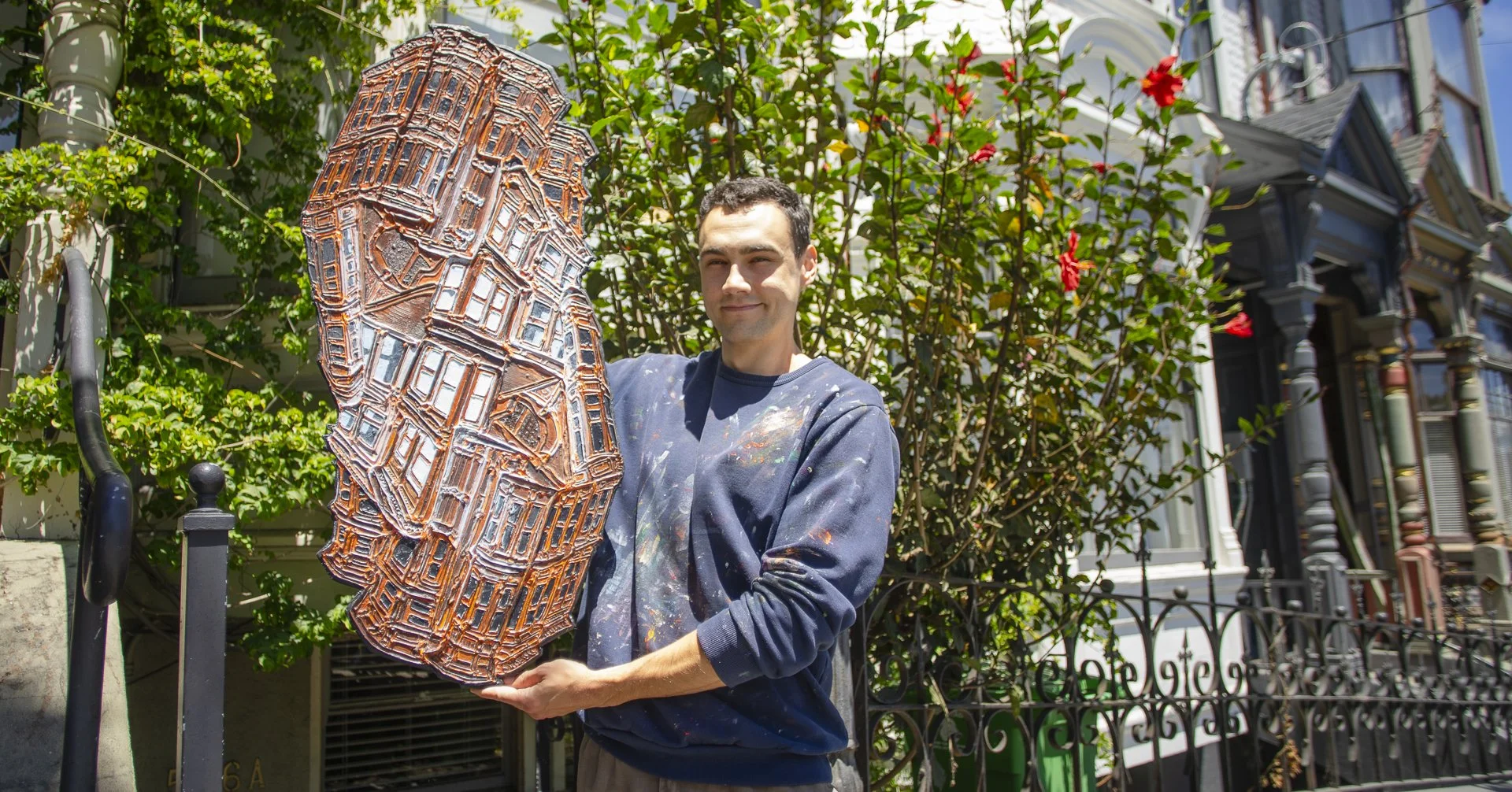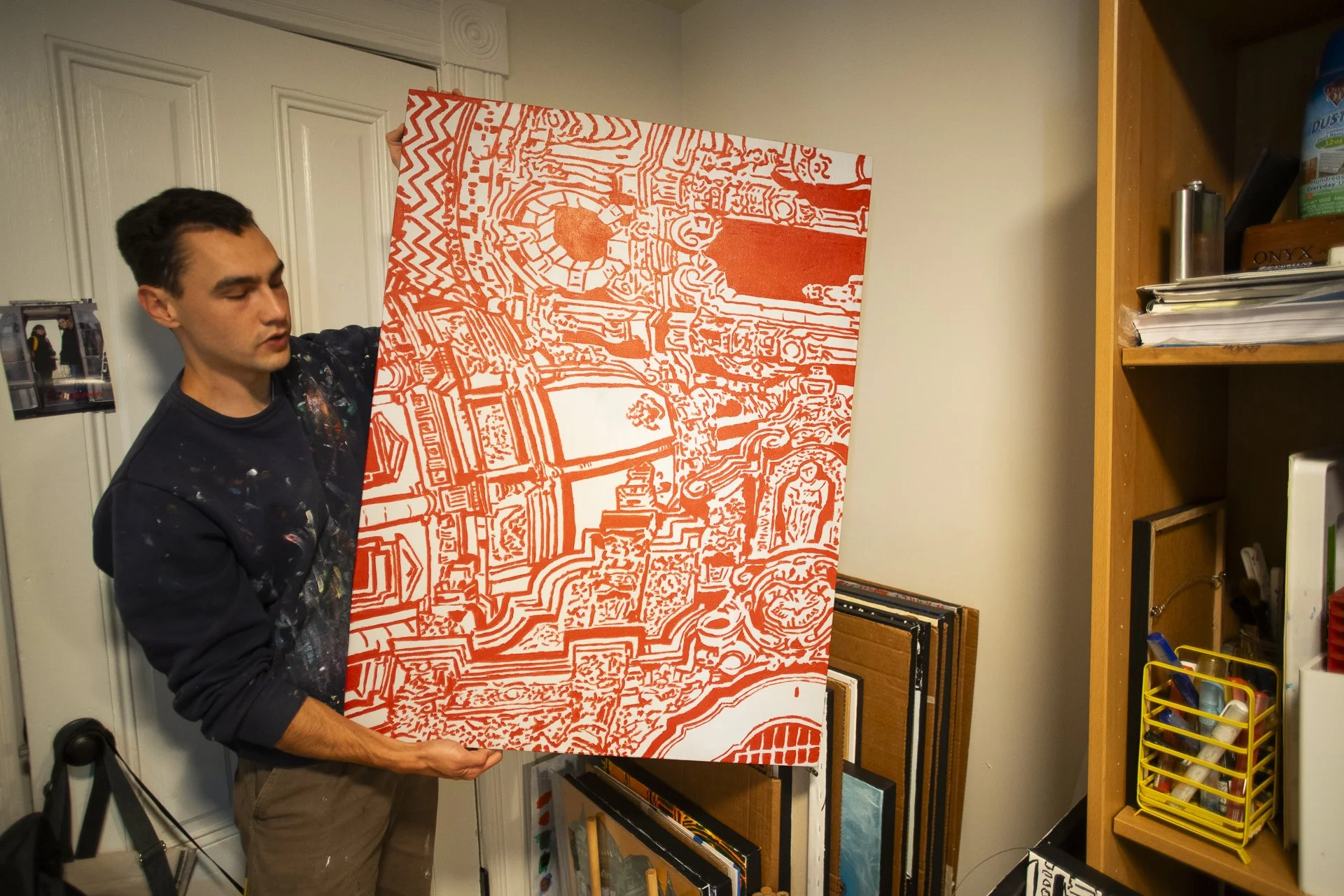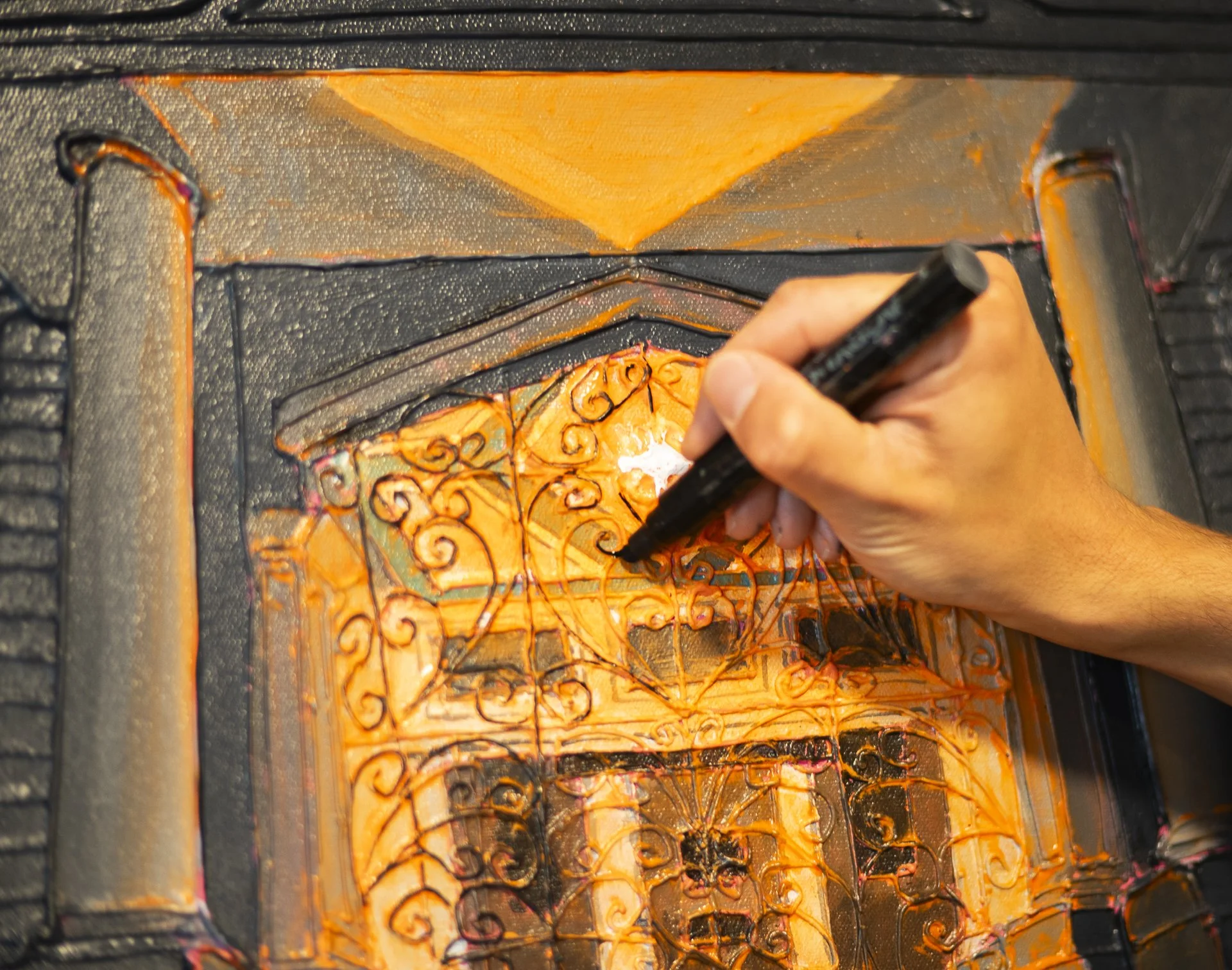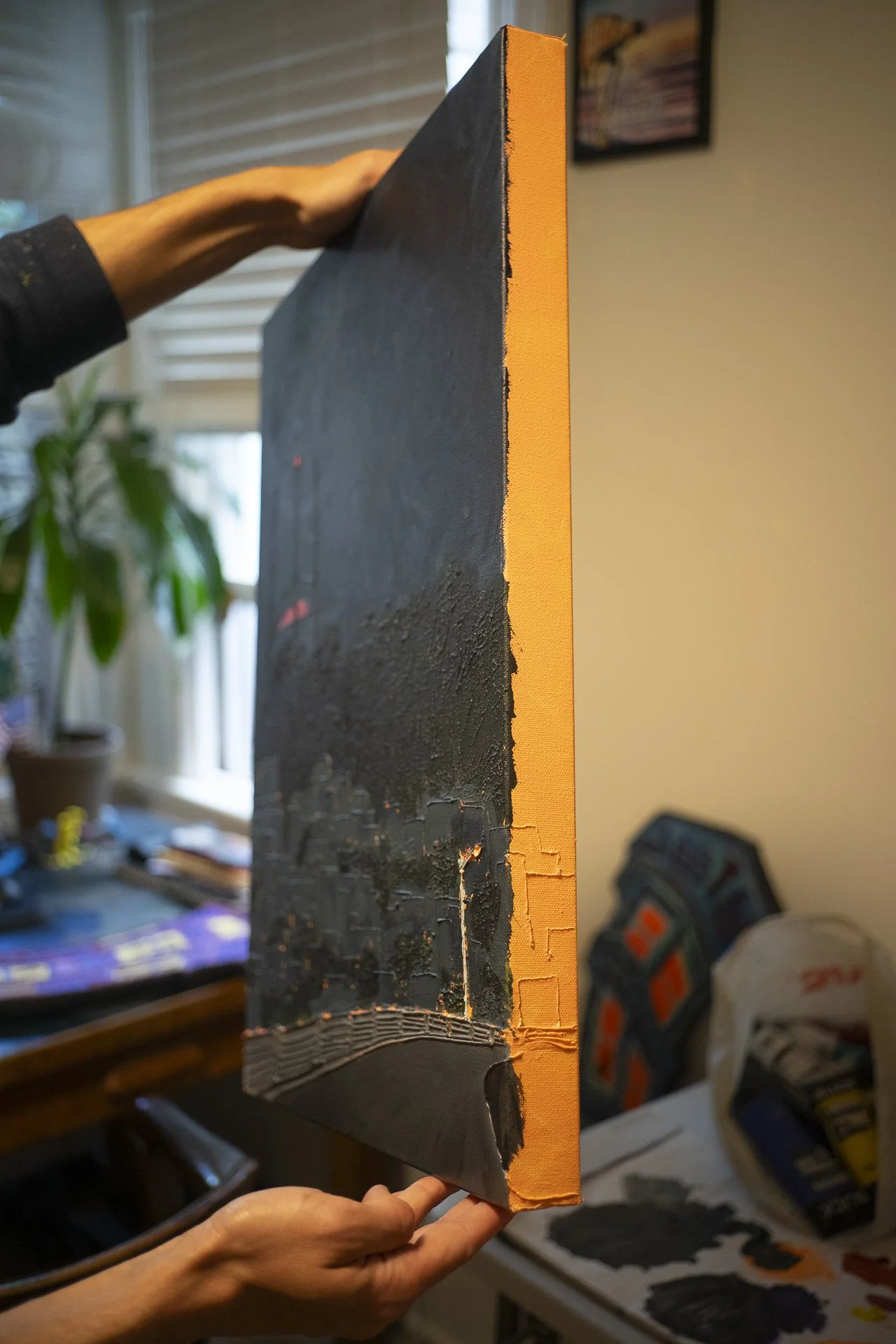Studio Visit & Interview With Alvar Jacomet
Interview and Photographs by Brandon Joseph Baker
Alvar Jacomet in his studio in San Francisco’s Lower Haight neighborhood.
I met Alvar Jacomet at his studio within his garden apartment on Oak Street in San Francisco. The space is minimal and focused on Alvar’s work. A few easels, a shelf filled with art supplies and knick-knacks, a folding table, a modest plant and a desk with a monitor sit on a thick paper cover which protects the carpet below. I notice in the corner an orderly stack of paintings which seem to have grown too big for the space, several works live outside the stack. The stack ebbs and flows, grows and shrinks continuously because Alvar shows work consistently in pop ups and group shows around San Francisco. His next showing will be at The City at Night at Moth Belly Gallery starting on August 7th, 2025.
Alvar is gentle, soft spoken and polite. He talks about his process and craft with thoughtfulness and care. We chat about a shared appreciation for science fiction and he mentions gaming as an inspiration for pursuing art. ‘I blame all of it for making me go to art school. The visual language and breadth of artwork of these pieces of media really resonated to 6-year-old me,’ Alvar says of his origins. Though inspired by these genres, his landscape works blend impressionism, surrealism, expressionism, impasto and a flair of arts and crafts.
A watercolor work by Oscar Boberg hangs on Alvar’s studio wall with a nod to Alvar’s inspirations of science fiction the environs of The Bay Area.
San Francisco’s Victorian architecture is a staple if not the driving force in Alvar’s art. He has explored these structures on canvas, prints and wood cuts. Some Victorians morph into entomological shapes, others float free of the horizon like an Imperial Star Destroyer, others bend in an organic smooth line as if being warped in a reflection. Across all of his work in the studio I see a lot of texture. Texture in the layers of color which literally accentuate the architectural elements of the Victorians.
‘Victorian Beetle #3 Recolored’ by Alvar Jacomet from his Victorian Beetle Series in 2022.
Interview
Thank you for taking the time to open your studio and meet with me. You’ll be showing a few pieces at Moth Belly Gallery during The City at Night group show. What can we expect to see from you at the show?
I’ll be showing 3 18x24” acrylic paintings. Aside from the theme of the show, I also wanted to use these pieces to convey the subtle omnipresence of tech in the city. As a physical space, SF is particularly static in development and housing, which contrasts with its reputation as a hub of constant technological disruptions. That tension is shown in each piece, some more subtly than others. I also hid cats in all of them.
‘The New Ladies’ by Alvar Jacomet on view at Moth Belly Gallery during The City at Night exhibition.
‘Sutro Sentry’ by Alvar Jacomet on view at Moth Belly Gallery during The City at Night exhibition.
What motivates you to create or where do the ideas formulate that come to life in your studio work?
I think the biggest motivation to create for me is the enjoyment of creating itself, followed by deadlines. Ideas start as doodles, then usually photoshop or procreate. Sometimes an art class is a great way to get the creative juices flowing.
I really enjoy how you blend perspectives and create new structures from the architectural details of Victorians. How did you land upon Victorians as a recurring theme in your work?
I found Victorians to be immediately intriguing because of their geometry. To me, the way these houses use ornamentation in such a gridded and busy manner is very akin to something between machinery and Legos. Combine that with an endless supply of Victorian architecture here in the bay, and you have a recipe for endless iteration.
You mentioned an appreciation for the historical permanence of Victorians and that you’re a member of The Victorian Alliance of San Francisco, please tell us a bit more about how this has influenced your art?
I appreciate the conflicting message that San Francisco sometimes gives off, where it’s this city that’s sitting on a giant fault line and is famous for its many intangible disruptions in tech and such, but at the same time is physically quite static and suffering from a chronic need for more housing and development. I find a lot of interesting conversations and ideas in that conflicting message. The Victorian Alliance is a great way to get to know these kinds of homes more intimately, as well as meet the people who strive to preserve them or just enjoy them for their beauty.
The Victorian where Alvar paints in his subterranean studio. He enjoys painting alfresco outside beneath the bay windows when weather permits.
How did you start working on cut wood and what determines the shapes and sizes you request from the fabricator?
Every piece I make starts as a photoshop collage, which I then trace on a surface using a projector. For the wood cuts, I do exactly this and then take the wood to get cut by my buddie, Forrester, in the Sunset. While he’s cutting the wood, I play soccer with his dog Odin. I will also help sanding the sides of the woodcuts afterwards, but really I mostly play with his dog.
I see your work around San Francisco frequently in group shows and pop ups, what is your take on the DIY art community here in San Francisco?
I love it. You’re only 1 person away from circling back to a friend. Everyone knows everyone, and it makes the art scene feel very accessible and varied. You can go full vendor pop-up mode, or show in local galleries, or even take over the walls at your local cafe. Once you start talking to people, nothing feels out of reach here.
Can you describe your experience showing your art as part of the DeYoung Open in 2023?
It was very validating, they gave me a really cool pin and put my name on the wall. I was lucky where they placed it, there were about 900 pieces in total and it was definitely a lot to take in. I’m excited to try for the next one!
You're originally from LA, and then moved to Argentina when you were 11, what brought you to The Bay?
As a young adult trying to save money, I found working in Argentina frustrating and unstable. It didn’t help that I went to art school but, oh well. Right before turning 24, I figured I’d come back to the US and just work for a while. My dad was living in the East Bay so I decided to come here and stay with him for a while before finding more permanent housing.
After some formal education in Buenos Aires at National University of Arts you continue taking courses at City College, can you describe for the readers how those two experiences differ?
Public colleges in Argentina don’t mess around, there’s no money, and lots to learn. You don’t pay tuition, you pay in emotional distress. Every semester starts with dozens of students per class, and ends with like 10 people. The teachers are great and your classmates are awesome. After 3 years though, I still had another 4 years left before I could graduate. All that for an art degree felt silly, and I wanted to start working more, so I dropped out and moved to the US.
City College is similar in some ways but much more accessible and merciful. I was also in a more mature head space, so I really took advantage of City College. It’s a place that meets you where you are and offers you tons of tools and knowledge if you want it. My ideas and ways of thinking are from my art school, but my techniques and discipline are from City College.
You have a unique technique for adding depth to your paintings with heavy gesso, paint and caulking; why do you use this method and what inspired it?
Those methods dry relatively quickly and aren’t too heavy or toxic. I reached these methods through experimentation and iteration. A big inspiration was just trying to recreate the grooves and lines on Victorians. At first I was trying to shape molding paste with a spatula, but I eventually realized that caulking was the way to go.
The edge of Alvar’s work shows the impasto style of application he uses to create depth, definition and texture in his art.
Can you elaborate on the specific nuance of science fiction and gaming that influenced your art practice?
“Greeble”, it refers to a very geometrically textured surface. A lot of sci-fi esthetics are based on greeble, it’s the kind of detailing you’d see either inside a printer or on the side of a spaceship. I really like greeble!
The landscapes of your paintings are typically void of people unless they are inside the structure, primarily silhouetted behind glass. Why do you introduce this element to your art in this manner?
The focus of my work is the houses themselves. I (and the viewer) am watching it all from the outside, be it a crazy collage or a glimpse into someone’s cozy evening. A lot of my ideas form while going for walks at night, when I’m often the only person around, so that solitary feeling is always present in my work.
A map on your wall marks the parks you and your partner have visited in San Francisco. You enjoying walking around the city to get inspiration, what do you find these outings bring for your art practice?
It’s a good excuse to take pictures and see new neighborhoods. Everytime I get a little burned out with painting, I come across a new batch of houses and it starts all over. Because all my pieces are from pictures I take, I need a constant stream of new subjects and angles, you can only get them from exploring.
What’s next for you after The City at Night?
I’m having a solo show at Decentered Arts and am doing Open Studios in September. You’ll probably see me at some popups here and there.
I look forward to seeing your finished works at Moth Belly in August. Thank you again for speaking with me about your work and process.
